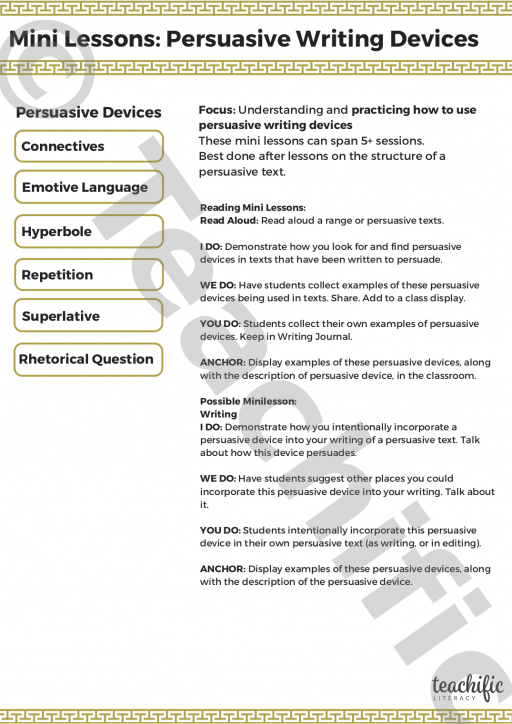About this teaching resource
Ever wondered how to bring some spark into your students’ persuasive writing? Or maybe you’re wondered how to bring some spark into teaching students this form of writing. Have some outrageously amazing fun playing with some of these positively polished Persuasive Writing Devices!
I’d cry a million tears if you didn’t find something in this collection of Persuasive Writing prompts, activities and feature charts that didn’t spark a renewed view of this form of writing.
Firstly, if you’re looking to improve your students’ current persuasive writing, introduce them to one or more of the Persuasive Writing Devices. Have them:
- Collect examples
- Create a classroom display
- Create their own examples or have them practice including new devices through some Quick Writes.
Secondly, if you’re looking to improve the structure and the strength of students’ evidence as they write, introduce them to one of the evidence structures: advantage, reason, outcome OR problem, result, solution.
Furthermore, if you’re looking to spark a reason to have your students write a persuasive text check your library for the story: Don’t Let the Pigeon Drive the Bus by Mo Williams. You’ll find Mini Lessons here at Teachific to support a unit of persuasive writing.
Lastly, if you’re looking to understand the features of persuasive texts look for our Info Sheet: Persuasive Writing. You’ll also find a matching Tally Chart listing some of the text features to help you and your students keep track of what you are incorporating into your writing and therefore monitor and reflect on success.
Have I persuaded you yet? Enjoy!
Mini Lessons Explained
The Mini Lesson is the powerhouse of effective demonstrations and collaborative practice of new learning.
Mini Lessons are short focused lessons that begin with teacher modelling (I Do), followed by students practicing with the teacher (We Do), to enable students to move off to practice the new learning independently.
Elements of an effective Mini Lesson:
- Students are gathered around the teacher as a community of learners, where they can clearly see what is being demonstrated and can easily engage with the learning.
- I DO The teacher demonstrates or models what it looks like/sounds like/feels when trying a new skill, strategy, process or action:
- Writing: Modeling by writing, enlarged text all students can see
- Reading: Modelling with authentic texts such as Big Book, enlarged text, or Read Aloud
- Reading and Word Study Mini Lessons frequently begin with familiar authentic texts, or at least involve the connection to a familiar authentic text. Sometimes the Mini Lesson requires a new text to be introduced, but mostly, Mini Lessons will draw on part of a whole text that is already familiar to the students. This enables students to focus on aspects of texts that already hold meaning.
- The learning is anchored, showing what success looks like through charts created on the spot. These might take the form of an ongoing dot point list or Tally Chart. It may include definitions, vocabulary, routines, process, examples, etc. Charts are kept visible, added to during subsequent lessons, referenced and used.
- WE DO Students practice elements of the skill, strategy, action together with the teacher, reflecting on the process, clarifying, questioning, learning how before moving off for independent practice. Teacher checks in with students to see who is ready to move to independent practice.
- Students who require more support might stay with the teacher to practice together based on the points of need, or the teacher might work side-by-side with a student who requires this extra support.
After Independent Practice (YOU DO) students benefit from the opportunity to share their learning, their experience, their discoveries or their wonderings. Turn and Talk is useful, or a few students sharing to the whole class offering opportunities for learners to share back with their community what they have experienced.
Our Teachific Mini Lessons are built around this powerful structure. Each Mini Lesson is designed to provide you with:
- Mini Lesson focus
- Prompt to begin with a familiar text
- Demonstrate
- Practice Together
Then you can focus on powering into:
- Practice independently
- Share
Choose from a range of Mini Lessons. Select a focus based on the needs of your students.
Many more are on their way.
Reviews
There are no reviews for this resource yet, why not write one?
Report a problem
Please log in to report a problem with this resource
Want this teaching resource?
Members get great benefits such as FREE access to premium resources like this one, discounts on courses and more.
Download includes: PDF 4 pages 143.4 kb








